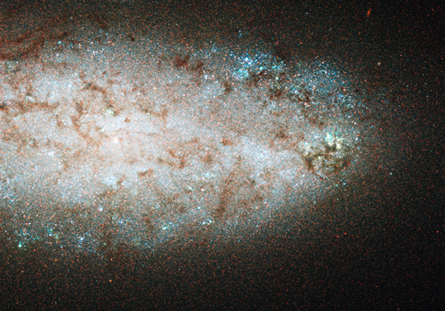The star party is almost over in a tiny galaxy 12 million light-years from Earth.

The bluish light emitted by young stars is flickering out in the dwarf galaxy, dubbed NGC 2976. The galaxy’s outer layers have already stopped making new stars, and star birth at the galaxy’s core will come to a halt in the relatively near future when its supply of star-forming gas is completely extinguished.
Benjamin Williams and Julianne Dalcanton of the University of Washington in Seattle and their colleagues ascribe the stellar snuff-out to a collision that NGC 2976 may have suffered about a billion years ago. The galaxy lies at the fringes of a galaxy cluster called M81. A glancing blow by one or more members of the cluster could have stripped gas, the raw material for making stars, from the outer layers of NGC 2976 and funneled it toward the center.
In most dwarf galaxies, star formation “peters out gradually” with distance from the core, but “in NGC 2976, star formation just stops cold” beyond a small region around the center, Dalcanton says.
Astronomers have long suspected that grazing collisions can channel gas toward the center of a galaxy. But newly released images taken by the Hubble Space Telescope, which resolves several hundred thousand individual stars in NGC 2976, provide the clearest evidence for the phenomena, Williams says. He and his colleagues describe their work, which also relied on radio observations to trace the movement of gas in the galaxy, in the Jan. 20 Astrophysical Journal.
Although NGC 2976 is classified as a spiral galaxy and has a star-forming disk, it lacks features typical of the Milky Way and other spiral galaxies, such as star-forming arms and a central bulge of stars. A past collision might account for the missing features as well as the high density of gas at the galaxy’s center, the researchers note.
Hubble caught the galaxy during a key epoch, Williams and his collaborators say. Star formation is now confined to a small region surrounding the galaxy’s center. In another half-billion years, new stars will cease to form even there. Then the party really will be over.







